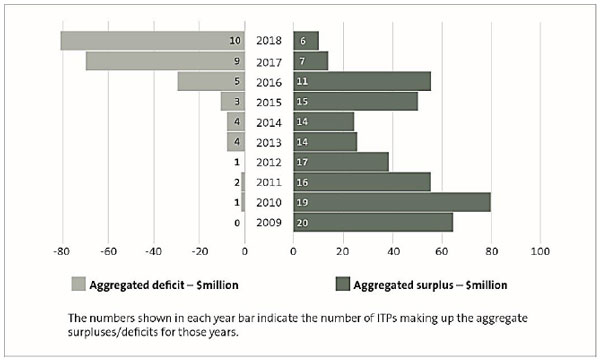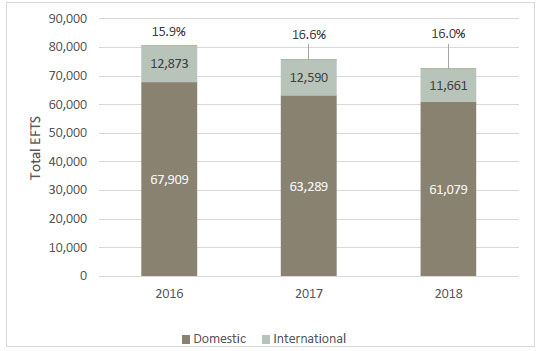Financial sustainability of the institutes of technology and polytechnics
Aggregated surpluses and deficits
2.1
In our report on the results of the 2017 audits, we focused mostly on the financial performance of the ITP sector.
2.2
Although not all ITPs were in financial difficulty, there had been a significant increase in the number that were, and in the size of the combined deficit, between 2016 and 2017.
2.3
Figure 2 shows that, by 2018, 10 ITPs returned an aggregated deficit of $81.6 million. This was an increase of $11.6 million from 2017, when nine ITPs recorded an almost $70 million aggregated deficit.
2.4
In 2018, six ITPs returned an aggregated surplus of $10.1 million. This was a decrease of $3.7 million from 2017, when seven ITPs recorded a $13.8 million aggregated surplus.
2.5
The combination of higher deficits and lower surpluses saw the aggregated overall deficit rise to $71.5 million in 2018, from $56 million in 2017.
Figure 2
Aggregated surpluses and deficits, 2009 to 2018

Source: Office of the Auditor-General financial statements database.
Individual ITP surpluses and deficits 2017 and 2018
2.6
In 2018, Wintec made a deficit of $991,000, having made a surplus of slightly more than $2.2 million in 2017. It became the tenth ITP in a deficit position.
2.7
Figure 3 shows that Toi Ohomai Institute of Technology, Manukau Institute of Technology (MIT), Western Institute of Technology at Taranaki (WITT), and Unitec reduced their deficits in 2018 (although Unitec still had a significant deficit of $29 million). WelTec, Whitireia, Tai Poutini, NorthTec, and Nelson Marlborough Institute of Technology (NMIT) all had larger deficits in 2018 than in 2017.
2.8
The Tertiary Education Commission (TEC) has a framework to monitor the financial viability of TEIs. One measure the TEC uses is operating surplus as a percentage of revenue, with a low-risk threshold at 3% or above.
2.9
Of the six ITPs making a surplus, only Southern Institute of Technology (SIT) and Otago Polytechnic made a return of greater than 3% of revenue (at 4.5% and 4.1% respectively). Otago Polytechnic’s surplus increased by about $1.3 million in 2018, while SIT’s surplus decreased by a similar amount.
2.10
As with last year, the main reason for revenue shortfalls was a continued decline in the number of equivalent full-time student (EFTS) enrolments. We discuss this further in the next section.
Figure 3
Individual ITP surpluses and deficits for 2017 and 2018

Source: Office of the Auditor-General financial statements database.
Student enrolments
2.11
Figure 4 shows that, overall, student numbers in the ITP sector continued to decline in 2018. Total domestic EFTS fell to 61,079 from 63,289 in 2017, and international EFTS fell to 11,661 from 12,590. International EFTS make up about 16% of the student intake, about the same proportion as in 2016.
Domestic student enrolments
2.12
At the individual ITP level, these effects are not felt equally. Tai Poutini lost more than half of its domestic students between 2017 and 2018 as it restructured its “student offerings”. NorthTec had 664 fewer domestic EFTS. WITT’s drop in numbers was lower, but it was the third highest in percentage terms. EIT, Otago Polytechnic, SIT, the Open Polytechnic, and the Universal College of Learning (UCOL) increased domestic enrolments.
International student enrolments
2.13
Whitireia, Unitec, NorthTec, WelTec, and NMIT saw the biggest declines in international student enrolments, while WITT, EIT, and Otago Polytechnic increased their international EFTS by the most.
2.14
A reorganisation at Immigration New Zealand (INZ) caused some delays in processing international student visas. INZ is also vetting some applications more rigorously because of the prevalence of fraudulent applications from some overseas agents.
2.15
INZ expects ITPs to apply the same rigour in accrediting prior learning. INZ noted an increased number of applications claiming exemption from one or two years of a three-year degree based on prior study in the student’s home location. INZ considers that some of these prior learning claims are not easily verifiable. After we discussed this with NZQA, it told us that it will start to look at the systems for accrediting prior learning of international students in TEIs.
Figure 4
Equivalent full-time student enrolments (EFTS) at ITPs, 2016 to 2018, including the percentage of international students

Source: ITP annual reports.
2.16
On 9 May 2019, INZ and Education New Zealand announced a joint programme of work to “support the education sector in recruiting quality students, communicating key messages, and navigating visa processing issues as they arise”. We will monitor this issue through our normal engagement with INZ and others in 2019 and 2020. It is currently unclear to us what proportion of visa delays are related to INZ’s reorganisation and what proportion are because of the real or perceived increased risk of fraud.
Summary of ITP sector’s financial performance
2.17
SIT and Otago Polytechnic continue to grow their operations. From 2019, SIT will also operate the Telford Campus of the former Taratahi Institute of Agriculture. SIT’s 2018 figures include:
- Music and Audio Institute New Zealand, purchased from Tai Poutini; and
- full ownership of South Lakes English Language College in Queenstown.
2.18
Otago Polytechnic has almost doubled its international EFTS since 2016, with 1116 out of a total of 1436 studying at its Auckland Campus. Its domestic student numbers have also increased after a dip last year.
2.19
UCOL achieved a 2.23% return as a percentage of revenue, more than doubling its 2017 surplus, and the Open Polytechnic’s domestic student intake has recovered to 2016 levels. Ara and EIT returned small surpluses.
2.20
Some TEIs are mitigating some of the effects of further declines in enrolments. WITT is the most notable, having reduced its deficit to $920,000 from $3.6 million in 2017.
2.21
However, the general picture in many of the ITPs is that cost reductions, even if implemented to plan, are running behind further falls in student enrolments.
The Government’s proposed reforms
2.22
In August 2019, the Government published its decisions on vocational education and training, and the Education (Vocational Education and Training) Amendment Bill is now at the select committee stage. The Education and Workforce Committee is due to report back to the House by February 2020.
2.23
If enacted in its current form, the Bill will convert the 16 ITPs to 16 Crown entity subsidiaries. These will be 100% owned by a new “parent” organisation with the working name of the New Zealand Institute of Skills and Technology. The Government appointed an establishment board for the new entity in September 2019.
2.24
Now that the Bill is progressing through the legislative process, we are focused on maintaining accountability during the transition process. Our submission on the proposed reforms highlighted several risks that need to be managed well. Those risks include maintaining good financial controls and governance, while managing a change process at the same time.
2.25
In periods of uncertainty, it is not unusual for staff to leave or to become disengaged. Loss of staff and goodwill can diminish effective safeguards. Basic good practice, such as maintaining separation of duties (for example, in payroll administration or procurement), can deteriorate. This creates the opportunity for fraud, misuse of public money, and misappropriation of assets from outside and from within the TEI.
2.26
We are providing support, consistent with our audit role, to the establishment board for the new institute to help it prepare for the Bill’s enactment and set up the new organisation. We can help mitigate some of the transition risks by sharing what we have learnt from similar major transitions and by answering any audit questions as they arise.

